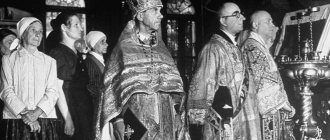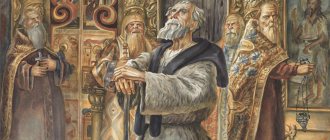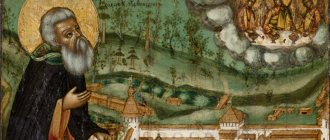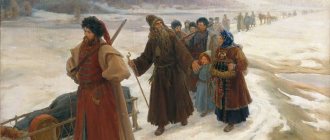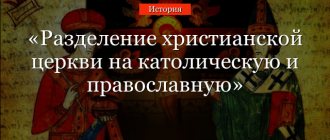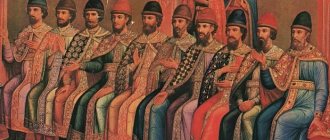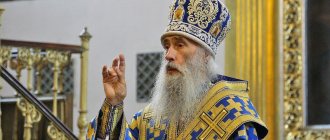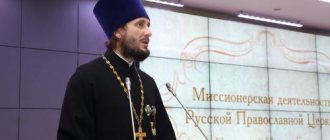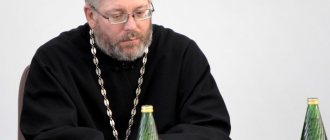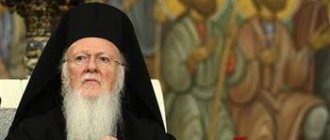- December 9, 2019
- Events
- Olga Strelkova
The schism in the Russian Orthodox Church occurred in the 17th century, and it began in Moscow in the 1650s. It has a close connection with the reforms carried out by Patriarch Nikon. The reforms were aimed at introducing changes to the liturgical books printed in Moscow and to some of the rituals. The purpose of these changes is unification with the Greek canons.
Church reforms in the 17th century
The implementation of reforms took place with the participation of Tsar Alexei Mikhailovich and with his support. And also with the support of some other Orthodox patriarchs. The reformation was confirmed by decrees adopted by a number of councils. They took place in Moscow from 1650 to 1680.
The reforms had opponents, who later became known as Old Believers. They were anathematized at the Moscow Councils of 1656 and 1666 and at the Great Moscow Council held in 1667. She touched those who held the sign of the cross with two fingers.
These events marked the beginning of the Old Believer schism in the Russian Church. Groups of Old Believers appeared, which were subsequently divided into numerous agreements. As a result of church reform, which led to a split in the church in Rus' in the 17th century, confrontation arose within the Russian people. Its consequences have not been completely overcome to this day.
Old Believers
In 1656, at a local council of the Russian Church, everyone who continued to make the sign of the cross with two fingers was cursed, excommunicated and declared heretics. At this time, the movement of the Old Believers began to take shape in some way and leaders appeared, among whom Archpriest Avakuum stood out. He fiercely resisted the reform, for which he was exiled by the authorities for 11 years and then publicly burned. In 1667, at the Great Moscow Council, the schismatics were again declared heretics. Then the country finds itself on the brink of a religious war. In 1668, the Solovetsky Monastery rebelled, where the monks refused to adopt innovations in church services, after which all possessions were confiscated from the monastery. The tsarist troops besieged the monastery for a long time, as a result of which they took it in 1676, as a result of which about 400 defenders of the monastery were killed and executed.
The story of the Moscow noblewoman Feodosia Morozova, a representative of one of the oldest aristocratic families, is also indicative. She was also an ardent opponent of the reform, for which she was deprived of property and imprisoned in a monastery, and then starved to death in a pit. Her image is widely known from the painting by V.I. Surikov’s “Boyaryna Morozova”, where she raises her hand with a double-fingered gesture, which has become the actual symbol of the Old Believers.
The persecuted Old Believers left their homes and went to remote areas, as a rule, to the forests, where they lived in communities. Such an isolated settlement of schismatics was called a monastery. The authorities did not like this state of affairs not only because of their refusal to accept the reform, but also because the people who went into the forests did not pay taxes. Thus, the Old Believers were wanted by the government. In this case, they preferred to kill themselves by burning themselves - they gathered in the same room with their children and set themselves on fire. The places where schismatics self-immolated were called “gari,” and at that time there were a great many of them throughout the country.
Note 2
Only in 1716 did Peter I issue a decree according to which the Old Believers could live peacefully and legally, but had to pay double tax.
Reasons for the reform
Before considering the church schism of the 17th century, it is worth examining the reasons for the reform. Discussions about the need for reform of church life began in the 1640s.
Then a group called the “Circle of Devotees of Piety” was created in the capital. The members of the circle were representatives of the clergy. They advocated that church texts and rules of worship be unified.
But at the same time, there was no unity on the issue of choosing a sample according to which changes needed to be made. Some offered ancient Russian church books as a standard, while others suggested Greek ones.
Ultimately, victory was won by those who advocated for bringing church rites and books into conformity with the canons of Byzantium. There are several reasons for this choice.
Background and reasons
Most historians note that by the 17th century a unique situation had developed in Russia. Many liturgical rites differed significantly from those around the world. In particular, the discrepancy was strongly manifested in comparison with Greek customs, which stood at the origins of the Christian traditions that appeared in Rus'.
There was also a noticeable difference in the icons and church texts, which had many inconsistencies, errors, and clerical errors. By that time, many church books had already been copied for several centuries and, of course, had a large number of inaccuracies.
The church ceremonies themselves were carried out according to the principle of “polyphony,” in which the clergyman, the clerk, and the parishioners themselves participated. As you understand, in such an abundance of voices it was difficult to even understand what they were talking about. Particular attention was paid to a separate tradition: in Rus' they were baptized with two fingers, and throughout the Christian world - with three.
Vasily Perov “Nikita Pustosvyat. Dispute about faith"
Justification for the choice of Greek canons
Among them are the following:
- The Russian state sought to strengthen its international position among countries that had adopted Orthodoxy. The “Moscow – Third Rome” theory, which was put forward by the Pskov elder Philotheus in the 15th century, was popular in government circles. After the schism of the Church that occurred in 1054, Constantinople was the spiritual center of Orthodoxy. According to Philotheus, after the fall of the Byzantine Empire, the capital of Rus' took up the baton, becoming a stronghold of the Orthodox faith. Therefore, it was completely logical to focus on the Greek canons in worship.
- After the decision of the Pereyaslav Rada in 1654, part of the Polish-Lithuanian Commonwealth, where the Orthodox population lived, passed to the Russian state. There the liturgy was carried out in accordance with the Greek canons. Thus, the unification of rituals could contribute to the process of unification of Russia with Little Russia.
- Not many years passed after the Time of Troubles, and periodically the country experienced outbreaks of popular unrest. In this regard, the government saw the establishment of uniform rules of church life as an important tool for stabilizing the internal political situation and maintaining national unity.
To understand how the schism of the Russian Orthodox Church took place, we should consider the main participants in the process of implementing church reform that led to it. Notable among them are Tsar Alexei Mikhailovich and Patriarch Nikon, who were the initiators of church reform in the 17th century.
Key events of the church schism
1652 - Nikon’s church reform;
1654, 1656 - church councils, excommunication and exile of opponents of the reform;
1658 - break between Nikon and Alexei Mikhailovich;
1666 - church council with the participation of the ecumenical patriarchs. Nikon's deprivation of the patriarchal rank, a curse on the schismatics;
1667-1676 - Solovetsky uprising.
Key figures: Tsar Alexei Mikhailovich, Patriarch Nikon, Archpriest Avvakum, noblewoman Morozova.
Reasons for the split:
1) the power-hungry desire of Nikon and Alexei Mikhailovich for the world Orthodox kingdom (“Moscow is the Third Rome”);
2) the process of centralization of the Russian state inevitably required the development of a unified ideology capable of rallying the broad masses of the population around the center;
3) political fragmentation led to the collapse of a single church organization, and in different lands the development of religious thought and rituals took its own path;
4) the need for a census of the sacred books (during the rewriting, mistakes were inevitably made, the original meaning of the sacred books was distorted, therefore, discrepancies arose in the interpretation of rituals and the meaning of their performance); Maxim the Greek began enormous work, acting as a translator and philologist, highlighting different ways of interpreting the Holy Scriptures - literal, allegorical and spiritual (sacred);
5) in February 1551, on the initiative of Metropolitan Macarius, a council was convened, which began the “church dispensation”, the development of a unified pantheon of Russian saints, the introduction of uniformity in church life, which received the name Stoglavogo;
6) during the reign of Alexei Mikhailovich and Patriarch Joseph, after long years of Troubles and the beginning of the restoration of the Russian state, the “topic of the day” became the problem with the introduction of triplets.
In March 1649, Nikon became Metropolitan of Novgorod and Velikolutsk, showing himself to be an energetic ruler. In 1650, Nikon took an active part in the massacre of the rebellious Novgorodians. On July 22, 1652, a church council elected Nikon as patriarch, who defended the principle of “priesthood above the kingdom.” Nikon's opponents: boyars, who were frightened by his imperious habits, former friends in the circle of zealots of piety.
The Council of 1654 approved the innovations and made changes to the divine service. Having the support of the tsar, Nikon conducted the matter hastily, autocratically, demanding the immediate abandonment of old rituals and the exact fulfillment of new ones. Russian culture was declared backward, and European standards were adopted. The broad masses did not accept such a sharp transition to new customs and greeted the innovations with hostility. Opposition to Nikon also formed at court (boyar F. P. Morozova, princess E. P. Urusova, etc.).
In December 1666, Nikon was deprived of the highest clergy (in his place was installed the “quiet and insignificant” Joasaph II, who was under the control of the king, i.e., secular power). The reason was Nikon’s extreme ambition and the intensifying conflict with Tsar Alexei Mikhailovich. Nikon's place of exile was the Ferapontov Monastery on White Lake. Secular power triumphed over spiritual power.
The Church Council (1666-1667) completed the triumph of the Nikonians and Grecophiles, canceled the decisions of the Stoglavy Council, approved the reforms and marked the beginning of the church schism. From now on, all those who disagreed with the introduction of new details in the performance of rituals were subject to excommunication from the church, received the name schismatics (Old Believers) and were subjected to severe repression by the authorities.
The split took the form of extreme confrontation: ideological factors were touched upon, and the polemics between the Old Believers and the Nikonians resulted in a real ideological war. The most influential of the church traditionalists were Ivan Neronov, Avvakum Petrov, Stefan Vonifatiev (who had the opportunity to become patriarch instead of Nikon, but refused to nominate his candidacy), Andrei Denisov, Spiridon Potemkin. The Church Council of 1666 anathematized and cursed as heretics and rebellious all those who did not accept the reform.
Alexey Mikhailovich Quiet
The church schism of the 17th century occurred during the reign of Alexei Mikhailovich, who reigned from 1645 to 1676. He was a very active ruler; he carefully delved into all issues of state life in Russia.
He positioned himself as a true believer, an Orthodox person, and all church affairs were under his supervision. Despite the fact that the nickname of Tsar Alexei Mikhailovich was the Quietest, he ruled in an alarming and turbulent time, which was overshadowed by many wars and other disasters.
The end of life's journey
Pustozersk was located at the “end of the earth,” but this did not frighten the pilgrims. They went there in an endless stream to communicate with the rebellious archpriest. They went back, hiding messages to the flock in their staffs, denouncing Nikonianism. Those messages called for the defense of “ancient piety.”
At the same time, it should be noted that the schismatics did not limit themselves to preaching the Great Russian rite.
Many of them called for self-immolation as the only way to save the soul. It is generally accepted that it was Habakkuk who initiated the self-immolation. But that's not true.
He considered self-immolation only as one of the means of fighting the Nikonians. Moreover, the person had to take such a step absolutely voluntarily and without coercion.
The very idea of self-immolation came from the theory of self-destruction of the elder Kapiton, whose activity occurred in the 30s of the 17th century. Capito's teaching is a life-denying heresy, since suicide was declared good. Such a view had nothing in common with genuine Christianity.
Monument to Archpriest Avvakum
In 1676, Tsar Alexei Mikhailovich died. Ascended to the Moscow throne. He was a quiet and impressionable man. He paid great attention to matters of piety. A rebellious Old Believer, whose health in the far north had already been considerably undermined, decided to take advantage of this.
He wrote a letter to the sovereign in which he reported that he had seen Alexei Mikhailovich burning in hell in a dream. He ended up in hell for rejecting the true faith and accepting Nikonianism. Thus, the freethinker, deprived of the degree of priesthood, wanted to turn the new king away from the Greek rite.
But Fyodor did not even think that his father could be a sinner. He considered the letter “a great blasphemy against the royal house.” After this, events began to unfold tragically.
Archpriest Avvakum was accused of all mortal sins and in 1682 he was burned in a log house along with his closest associates. Thus ended the life of an amazing and persistent man who accepted martyrdom for his faith.
At the beginning of the 20th century, the Old Believer Church canonized him as a saint, and a monument was erected in the village of Grigorovo at the end of the 20th century.
Mikhail Starikov
Patriarch Nikon: influence on the Tsar
The church schism in Russia is inseparable from the name of Patriarch Nikon. In the world he is known as Nikita Minin. The years of his life are 1605-1681. He became a clergyman at the behest of his parents and in this field reached great heights. In 1643, he received a significant church position, becoming abbot of the Kozheozersky monastery, located in the Arkhangelsk province.
In 1646, Nikon arrived in Moscow on monastery business, and he was introduced to the then young Tsar Alexei Mikhailovich. The latter was 17 years old at the time. The young sovereign liked the abbot so much that he decided to leave him at court and appointed him to the post of archimandrite in the Moscow Novospassky Monastery. Subsequently, thanks to the royal favor, Nikon became the Metropolitan of Novgorod.
In 1651, the tsar demanded the return of Nikon to the capital, and since then he began to influence Alexei Mikhailovich with even greater force. Enjoying the full trust of the ruler, the clergyman took an active part in solving state affairs.
The pinnacle of Nikon's career was his accession to the patriarchal throne. This happened after the death of Patriarch Joseph in 1652. From that moment on, preparations for the long-overdue church reform began.
The essence of the reforms of Patriarch Nikon
The first thing the activity of the newly-minted patriarch was aimed at was the editing of spiritual literature, which had to be coordinated with the Greek canons. As for the date of the church schism, it dates back to 1653, when changes to the liturgical canons began to be introduced. This is where the confrontation between Patriarch Nikon and his followers and supporters of the old rituals began.
Next, we will consider the essence of the reforms that led to the split of the Orthodox Church. It boils down to this:
- The two-finger sign has been replaced with a three-finger sign. It was this innovation that caused the most criticism among opponents of the reforms. They believed that the sign of the cross performed in a new way carried disrespect for the Almighty, since the so-called fig for God was formed from three fingers.
- Instead of “Jesus” they began to write “Jesus”.
- The number of prosphoras during the liturgy was reduced.
- During the service, it was necessary to make bows from the waist, not to the ground.
- When performing a religious procession, it was necessary to move against the sun.
- Instead of two “Hallelujahs,” church singing began to repeat this exclamation three times.
It should be noted that it was the reforms of Patriarch Nikon that led to years of church schism in Rus'.
Harsh methods and the deposition of Nikon
During the process of church schism, a significant part of the Orthodox believers separated from the Orthodox Church and began to oppose the reforms introduced by Patriarch Nikon. The reason was largely due to Nikon's harsh methods.
In 1660, at the behest of Alexei Mikhailovich, the patriarch was deposed. Subsequently, he was deprived of the priesthood and exiled to the Ferapontov Monastery in Belozersk.
Reasons for the split
Let's look at them in more detail.
- The methods of implementing church reforms were very harsh. They alienated many members of the clergy and part of the common people. These methods were as follows: church books, icons and other shrines that did not comply with the Greek canons were forcibly confiscated. Later they were publicly destroyed.
- The abruptness and thoughtlessness of the transition to new rules of liturgical rites led to the fact that the people formed the conviction that they wanted to impose a different faith on them. In addition, those who refused to accept the innovations were subjected to severe corporal punishment. And this could not add sympathy to the patriarch and his entourage.
- The parish clergy had a very low level of education, and sometimes the priests were simply illiterate in matters of faith and therefore could not clearly explain to the parishioners what the essence of the changes was.
- Inaccurate translation from Greek into Russian of individual texts, which, although slightly, still differed from the previous Old Russian ones. The greatest indignation of believers was that the meaning of the “Creed” prayer had changed. Previously, the Kingdom of God was spoken of in the present tense, but now - in the future.
- There was no unity in the church environment on issues of reform. Therefore, opponents of innovations appeared there too, they became the spiritual leaders of the Old Believers.
Next, a few words should be said about the leader of the schism of the church in Rus' - Archpriest Avvakum.
Split
Archpriest Alexander Fedoseev
A schism is a violation of complete unity with the Holy Church, with the exact preservation, however, of the true teaching about dogmas and sacraments. The Church is unity, and its entire existence is in this unity and unity about Christ and in Christ: “For we were all baptized by one Spirit into one body” (1 Cor. 12:13). The prototype of this unity is the Trinity Consubstantial, and the measure is catholicity (or conciliarity). Schism, on the contrary, is separation, separation, loss and denial of conciliarity.
The question of the nature and meaning of church divisions and schisms was raised with all its severity already in the memorable baptismal disputes of the 3rd century. St. Cyprian of Carthage with inevitable consistency then developed the doctrine of the complete gracelessness of any schism, precisely as a schism: “We must beware of not only obvious and obvious deception, but also that which is covered with subtle slyness and cunning, as in the invention of the enemy of a new deception: the very name a Christian to deceive the unwary. He invented heresies and schisms to overthrow faith, pervert truth, and dissolve unity. Whoever cannot be kept on the old path by blindness is led astray and deceived by the new path. It delights people from the Church itself and, when they were apparently already approaching the light and getting rid of the night of this age, a new darkness again spreads over them, so that they, not adhering to the Gospel and not preserving the law, nevertheless call themselves Christians and, wandering in darkness, they think that they are walking in the light” (Book on the Unity of the Church).
In a schism, both prayer and alms are fueled by pride - these are not virtues, but opposition to the Church. For them, schismatics, ostentatious goodness is only a means to tear people away from the Church. The enemy of the human race is not afraid of the prayer of a schismatic who is proud at heart, for the Holy Scripture says: “Let his prayer become sin” (Ps. 109:7). The devil finds their schismatics, vigils and fasts funny, since he himself does not sleep or eat, but this does not make him a saint. Saint Cyprian writes: “Is it possible for someone who does not adhere to the unity of the Church to think that he keeps the faith? Is it possible for someone who resists and acts contrary to the Church to hope that he is in the Church, when the blessed Apostle Paul, discussing the same subject and showing the sacrament of unity, says: one body, one Spirit, just as the calling is fast in the one hope of your calling ; one Lord, one faith, one baptism, one God” (Eph. 4:4-6)? It is characteristic that schismatics consider all other schisms, except their own, to be disastrous and false, arising under the influence of passions and pride, and they accept their own schism, which is not much different from others, as the only happy exception in the entire history of the Church.
The schismatics, shedding crocodile tears over the “violation” of the canons of the Church, in fact long ago threw under their feet and trampled all the canons, because the true canons are based on the belief in the unity and eternity of the Church. The canons are given to the Church, outside the Church they are invalid and meaningless - so the laws of the state cannot exist without the state itself.
Hieromartyr Clement, Bishop of Rome, writes to the Corinthian schismatics: “Your division has corrupted many, plunged many into despondency, many into doubt, and all of us into sadness, but your confusion still continues.” The unrepentant sin of schism is even more terrible than the sin of suicide (a suicide destroys only himself, and a schismatic destroys both himself and others, therefore his eternal fate is worse than that of a suicide).
“The Church is one, and she alone has all the fullness of the grace-filled gifts of the Holy Spirit. Whoever, no matter how, departs from the Church - into heresy, into schism, into an unauthorized gathering, he loses the communion of God's grace; We know and are convinced that falling away into schism, into heresy, or into sectarianism is complete destruction and spiritual death,” this is how Hieromartyr Hilarion (Troitsky) expresses the Orthodox teaching about the Church.
People susceptible to distortion of faith even try to use the word “schism” less. They say: “official Church” and “unofficial”, or “different jurisdictions”, or prefer to use abbreviations (UOC-KP, etc.). Saint Philaret of Moscow: “Orthodoxy and schism are so opposed to each other that the patronage and defense of Orthodoxy should naturally constrain the schism; condescension to schism should naturally embarrass the Orthodox Church.”
The history of the Orthodox Church in the countries of the post-Soviet space in recent years is full of important and dramatic events, many of which continue to have a powerful influence on the current state of the Russian Orthodox Church. The Soviet Union has collapsed, social stratification of society is growing, and problems related to information inequality are growing. The Russian Orthodox Church has preserved its unity throughout the entire territory of the former Soviet Union, creating new forms of church structure. Over the past decade, autonomous Local Churches have been formed, which reflects the new political realities of the modern world. It is appropriate to talk about radical changes in the CIS countries related to the understanding of the unity of the Church today. We are talking primarily about the canonical and social aspects of Orthodox ecclesiology.
Negative phenomena, of course, include the processes of rapid politicization of religious life in the countries of the former Soviet camp. The involvement of nationalist political parties in it created the basis for the subsequent formation of political-religious structures hostile to Orthodoxy such as the UGCC, UAOC, UOC-KP, IOC, etc. But no less dangerous are internal contradictions, disagreements and disciplinary-psychological splits within the church. parish life.
The main feature of disciplinary-psychological splits, from which all other parachurch movements are derived, is their emergence in the era of the collapse of socialism and in the midst of the death of mass atheism. Since there is no scientific literature yet that specifically treats the activities of church schisms and new sects, it seems appropriate to briefly characterize a number of features that distinguish them from traditional sectarianism.
First of all, disciplinary and psychological splits spread mainly not in rural areas, but in large cities, with a dense cultural and educational infrastructure. As studies have shown, church schisms find the most fertile soil among specialists with secondary and higher education. Hence the active professional orientation of the newest schisms: they try to religiously comprehend and “sanctify” the activity of man as a specialist. It is the specialty that is the area of the most intense sectarian and schismatic self-awareness and self-determination. Therefore, new sectarians are often grouped according to professional characteristics - of course, associations of this kind can also include ordinary amateurs who show interest in this profession. Associations of a schismatic type are created among writers, historians, doctors, and physicists who are trying to give a religious interpretation of the facts in their subject area.
Some people like to justify schismatics, saying that they were allegedly forced to retreat from the Church by some difficult circumstances - some of them were treated poorly or unfairly, offended, etc. But these excuses are not worth a damn. This is what St. said about them. Dionysius of Alexandria, in a letter to the schismatic Novatus: “If, as you say, you separated from the Church involuntarily, then you can correct this by returning to the Church of your own free will.” Priest Pavel Florensky once said: “I would rather sin with the Church than be saved without the Church.” Florensky wanted to say that only in the Church is salvation and that by leaving the Church, a person commits spiritual suicide. Schisms were born with shouts of victory, and died with dull groans, but the Church still lived! Condemned to death by schismatics, she exists, she is full of spiritual powers, she remains the only source of grace on earth.
In order to prevent the emergence of heresies, the Russian Orthodox Church has always tried, through exhortation and persuasion, to return those who have fallen away to the path of true faith, genuine Christian piety, and has tried again and again to gather its lost sheep, who have lost the voice of their shepherd. We must not forget about the great danger to the spiritual health of every person emanating from a possible fall into heresy through schism, since a heretical worldview penetrates much more deeply into the soul and infects it with the sores of sin, which are very difficult to get rid of.
The Holy Fathers recognize the possibility and necessity of healing the schism in the spirit of church economy. Saint Basil the Great, in the Rules from the First Canonical Epistle to Amphilochius of Iconium, points out the peculiarities of accepting repentants from schisms:
“For example, if someone, having been convicted of sin, is removed from the priesthood, does not submit to the rules, but himself retains the position and priesthood, and with him some others retreat, leaving the Catholic Church, this is an unauthorized gathering. To think about repentance differently than as existing in the Church is a schism... To accept the baptism of schismatics, as not yet alien to the Church; and those in unauthorized gatherings - to correct them with decent repentance and conversion, and to re-join the Church. Thus, even those in the ecclesiastical ranks, having retreated along with the disobedient, when they repent, are often accepted again into the same rank.”
St. very aptly defines the schism. Irenaeus of Lyons: “Christ will judge those who cause schisms, those who do not have love for God and who care more about their own benefit than about the unity of the Church, who, for unimportant and random reasons, dissect and tear apart the great and glorious body of Christ and, as much as depends on them, destroying it, talking about peace and making war.” (Five Books Against Heresies, 4.7).
As we can see from the statements of the holy fathers and a small analysis of the problem of schisms, they need to be healed, or even better, prevented. It is quite obvious that, in addition to the personal charisma of the next dissenter, a big role is played by the low spiritual education of his followers, political unrest in the state, and personal motives. The time has come to develop a large-scale project to prevent church schisms, covering all possible aspects of this problem. It is absolutely necessary to create some body, a church structure with extensive powers, capable of providing the proper level of monitoring of the spiritual state of believers and promptly nipping in the bud schismatic movements in the ranks of the Russian Orthodox Church.
Schism is a real danger not only to the integrity of the Church, but first of all to the spiritual health of schismatics. Such people voluntarily deprive themselves of saving grace and sow division within the unity of Christians. The split cannot be justified from any point of view: neither political, nor national, nor any other reasons can be considered as a sufficient reason for the split. There can be neither sympathy nor understanding for the schism and its leaders - church division must be fought and eliminated - so that something worse does not happen.
Activities of the Old Believers
Thus, Nikon's reforms were rejected by a significant number of believers, whose protest resulted in a religious war. The Old Believers were persecuted, the government persecuted them, and they sought salvation in remote corners of the Russian State. In response to church policy, the Old Believers staged mass self-immolations, which were called burnings.
Historical literature often characterizes the church schism as the starting point of massive popular unrest that periodically engulfed Russian lands in the 17th and 18th centuries. In fact, the Old Believers gained strong support from ordinary people; those who were dissatisfied with the existing order in the country gathered around them.
Results of the split
They can be briefly characterized as follows.
- The church schism of the 17th century grew into a national tragedy. The Russian people were divided into those who remained in the bosom of the Orthodox Church, who performed divine services according to the new canons, and the Old Believers, who adhered to the pre-reform rules.
- As a result of the schism, the spiritual unity of the Russian people was destroyed. For the first time in the history of the country, hostility on religious grounds arose.
- Priority was established over ecclesiastical power over secular power. The reform process was initiated by the tsarist government and took place with its full support. This was the beginning of the transition of the management of church affairs to state institutions. The completion of this process already occurred under Peter the Great, who abolished the patriarchate.
- The international position of the Russian state and its connections with the countries of the Orthodox world have noticeably strengthened.
- The Old Believers movement influenced the development of Russian art, making its own contribution to it. Spiritual centers and their own school of icon painting were created, and the ancient Russian traditions of writing books and znamenny singing were preserved.
In conclusion, let us consider the change in the views of the Russian Orthodox Church on the Old Believers.
Ideology of the split
Despite the persecution and repressive measures, the movement of the Old Believers did not stop, but, on the contrary, captured the entire territory of the Russian state. Then the church took extreme measures. At the Orthodox Council, in the mid-17th century, all who professed the ancient faith were excommunicated from the bosom of the church and given over to the church curse - anathema. At the same time, new ritual actions were officially adopted and new liturgical books were published.
The most negative thing about the church reform was that everything originally Russian, connected with the centuries-old history of Russia, was subject to merciless destruction.
The evolution of the attitude of the Russian Orthodox Church towards the Old Believers
As mentioned above, the councils of 1656 and 1666 condemned the supporters of the “old rites,” calling these rites unorthodox and heretical. This condemnation was finally sanctioned by the Great Moscow Council of 1667. At it, the reforms carried out by Patriarch Nikon were approved, and everyone who did not accept the council’s decisions was anathematized as heretics and disobedient to the Church.
However, starting from 1800, the use of old rituals began to be accepted to one degree or another by the Holy Synod. In 1971, a local council was held to elect a patriarch. The issue of the Old Believers was considered and the following decision was made.
A resolution of the Synod of 1929 was approved regarding the recognition of old Russian rituals on an equal basis with new ones. In 1974, a similar decision was made by the Russian Orthodox Church Abroad. But despite this, prayer communication between any large-scale church jurisdiction of Old Believers and New Believers was not resumed.
The causes and essence of the split in the assessments of contemporaries and historians
a) Avvakum Petrov, Ivan Neronov, Epiphanius, Deacon Fedor, Spiridon Potemkin (schismatics): denunciation of the wrongness of the Nikonians (and the strongest argument in the struggle was mass martyrdom - “sacrificing” oneself for the faith).
b) Simeon of Polotsk, Patriarch Joachim, Bishop Pitirim, Metropolitan Macarius (spiritual-academic school): condemnation of schismatics, accusing them of “ignorance”, “inertia”, “stubbornness”, “heresy” in order to prove the Old Believers wrong.
c) V. O. Klyuchevsky: the problem of the schism is the problem of the Third Rome, Holy Rus', Ecumenical Orthodoxy, the schism contributed to the spread of Western influences; highlighted not only the church-historical, but also the folk-psychological side of the schism.
d) S. M. Solovyov: schism is a conflict that affected only the sphere of ritual.
e) A.I. Herzen, M.A. Bakunin: schism is a manifestation of the freedom of spirit of the Russian people, proof of their ability to stand up for their beliefs.
